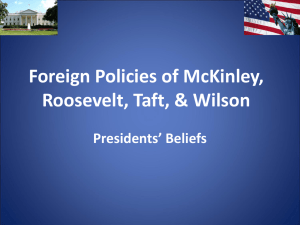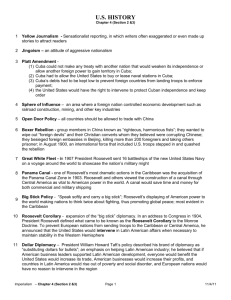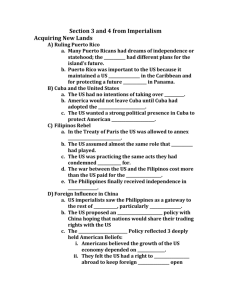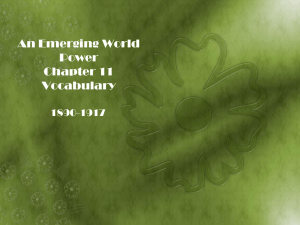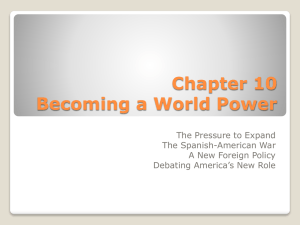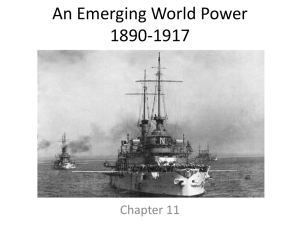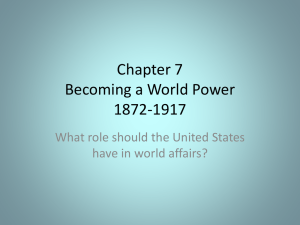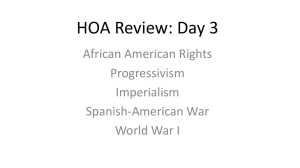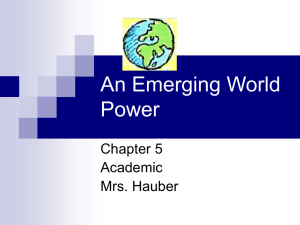CH. 7 Becoming a World Power
advertisement
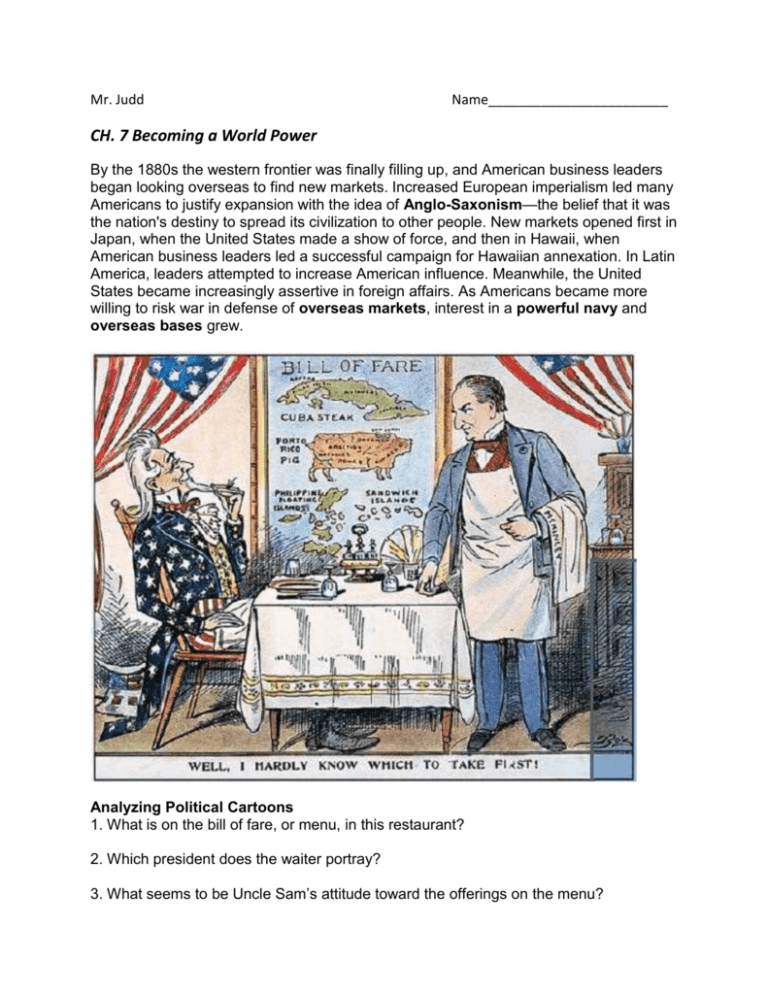
Mr. Judd Name________________________ CH. 7 Becoming a World Power By the 1880s the western frontier was finally filling up, and American business leaders began looking overseas to find new markets. Increased European imperialism led many Americans to justify expansion with the idea of Anglo-Saxonism—the belief that it was the nation's destiny to spread its civilization to other people. New markets opened first in Japan, when the United States made a show of force, and then in Hawaii, when American business leaders led a successful campaign for Hawaiian annexation. In Latin America, leaders attempted to increase American influence. Meanwhile, the United States became increasingly assertive in foreign affairs. As Americans became more willing to risk war in defense of overseas markets, interest in a powerful navy and overseas bases grew. Analyzing Political Cartoons 1. What is on the bill of fare, or menu, in this restaurant? 2. Which president does the waiter portray? 3. What seems to be Uncle Sam’s attitude toward the offerings on the menu? Survey Questions Procedures: Opening the lesson 1. The teacher will show a short clip from the movie, The Lion and the Wind. (The movie is a fictionalized account of an American who was kidnapped by an Arab sheik, creating an international incident leading TR to contemplate intervening by sending in the Great White Fleet). Ask students what region of the world is the scene taking place? Why would the United States want to send its military into the North African/Middle East region? 2. The teacher will distribute copies of the questionnaire, “When should the United States use Military Power?” Students will record their answers to the questions. The teacher will lead a discussion about the questions, soliciting students’ views about when it is appropriate to use the military against a foreign power. Directions: Write agree or disagree next to each statement. 1. The United States should use military force only if attacked by a foreign nation first. 2. It is justifiable for the United States to use military force to protect U.S. financial interests. 3. It is justifiable to go to war to defend an ally of the United States. 4. It is acceptable for the United States to promote Christianity in other nations. 5. Diplomacy is the only acceptable foreign policy. 6. It is acceptable to go to war to remove dictatorships and promote democracy. 7. It is the United States responsibility to be the “policemen” of the world. 8. President Washington was correct – the United States should avoid foreign entanglements. 9. Only a weak President would fail to protect United States interests in Latin America and the Caribbean. 10. It might not be politically correct, but the United States really is a superior nation. 11. The United States must maintain a superior military force for national security. 12. A wealthy nation like the United States should offer economic or military aid when a weaker nation requests it. Causes of American Imperialism Mr. Judd First things first. Turn to Pg. 262 in text and define Imperialism___________________________________________________________________ Directions: Read the documents below and summarize the motivations for U.S. imperialism in the space provided. Document #1: Josiah Strong, Our Country: Its Possible Future and Its Present Crisis. American Home Missionary Society, 1885 It seems to me that God, with infinite wisdom and skill, is training the Angle-Saxon race for an hour sure to come in the world’s future… The unoccupied arable [farmable] lands of the earth are limited, and will soon be taken… Then will the world enter upon a new stage of its historythe final competition of races, for which the Anglo-Saxon is being schooled... Then this race of unequaled energy, with all the majesty of numbers and the might of wealth behind it- the representative, let us hope, of the largest liberty, the purest Christianity, the highest civilization… will spread itself over the earth. If I read not amiss, this powerful race will move down upon Mexico, down upon Central and South America, out upon the islands of the sea, over upon Africa and beyond. And can any one doubt that the result of this competition of races will be the “survival of the fittest”?... Document #2: Navy Captain Alfred T. Mahan, The Influence of Sea Power upon History, (1890) Having therefore no foreign establishments, either colonial or military, the ships of war in the United States, in war, will be like land birds, unable to fly far from their own shores. To provide resting places for them, where they can coal and repair, would be one of the first duties of a government proposing to itself the development of the power of the nation at sea.” Document #3: Albert J. Beveridge, Senate Campaign Speech, 1898 American factories are making more than the American people can use: American soil is producing more than they can consume. Fate has written our policy for us; the trade of the world must and shall be ours… We will establish trading posts throughout the world as distributing points for American products. We will cover the ocean with our merchant marine. Great colonies governing themselves, flying our flag and trading with us, will grow about our posts of trade. Our institutions will follow our flag on the wings of commerce. Motivations for Imperialism Directions: Identify several factors that motivated American imperialism in the space below. 1. 2. 3. 4. AMERICAN EXPANSION Territory Date Acquired Alaska 1867 Samoa 1899 Midway Islands 1867 Mr. Judd How Acquired Why Acquired U.S. Secretary of State William Seward purchased Alaska from Russia for $7.2 million dollars (2 cents an acre). At the time, critics thought Seward was crazy and called the deal "Seward's folly." -Keep the British out -Potential for resources (minerals, furs, etc.) The U.S. began leasing the harbor at Pago Pago. In 1899, the U.S., Great Britain, and Germany all divided islands in the South Pacific in the Treaty of Berlin. Naval bases to protect American trading ships on their way to Asian markets. Annexed by the U.S. under Secretary of State William Seward. They were previously uninhabited. Naval bases in the Pacific. Purchased from Denmark under threat of seizure. The U.S. was afraid that Germany would take them first. -To prevent Germany from gaining them as naval bases. -Naval bases from which to protect the sea lands into the Caribbean Sea. Hawaii Philippines Puerto Rico Guam Panama Canal Virgin Islands 1917 Spanish-American War: Beginnings In the mid-1890s, there were serious social, economic, and political problems on the neighboring island of Cuba. Cuban rebels were attempting to free Cuba from Spanish control which dated back to the late 1400s. As Cuba lies only ninety miles from the tip of Florida, the United States has always taken a strong interest in the events happening there. At that time, many Americans sympathized with the efforts of the Cubans. Also, many had invested heavily in the Cuban sugar industry. In 1896, the Spanish government attempted to put an end to the rebel cause. General Valeriano Weyler was sent to crush the rebellion. Weyler destroyed sugar plantations and built prison camps for Cubans in rebel-held areas. News of mistreatment of the Cubans came to America. Stories were told of 100,000 captured Cubans starving to death in the Spanish camps. The atrocities were given much coverage in the American press, and in some cases reports were grossly exaggerated. Although many Americans were prepared to support the Cubans in their move for independence, President McKinley took a cautious stance. He had hoped the situation would be resolved in the near future, but a series of events made a simple answer impossible. One highly publicized event was the publishing of a letter that was intercepted en route to a post office in Havana, Cuba. Written by a Spanish diplomat stationed in Washington, the letter insulted McKinley and referred to Mr. Judd him as a "weakling" and a "crowd pleaser." The derogatory tone of the letter angered many Americans. More serious in nature, a second event involved the deaths of American sailors. On the night of February 15,1898, an explosion rippled through the hull of the Maine, an American vessel docked in the Havana Harbor. The ship had been sent to protect Americans on the island. No one was ever to know for sure who or what had caused the explosion in which more than 250 Americans lost their lives. The tragedy stirred the American spirit, and many blamed the Spaniards. Public pressure finally forced McKinley to take action. On April 11, the President went before Congress to request a declaration of war against Spain. Two weeks later, on April 25, the United States declared war against the old colonial power. With the rallying cry, "Remember the Maine," many Americans eagerly joined the fight. USS Maine Explosion Review Questions 1. Why do you think many Americans supported the Cuban rebels in their efforts against Spain? 2. What two events caused that support to increase? 3. What role did the press play in this war? What is yellow journalism? (See Pg. 269 in text) Spanish-American War: Battles and Outcome Even before the official declaration of war against Spain, the American fleet in the Pacific was steaming off to the Philippines, which had been a part of the Spanish empire for over 300 years. In the event that war was declared against Spain, they were to capture the enemy squadron in Manila, the Philippine capital. On May 1,1898, just days after the official declaration of war, Commodore George Dewey and six ships arrived in Manila Bay to begin bombardment of the fleet. In a matter of hours, the United States navy had destroyed the Spanish fleet and blockaded the harbor. American troops entered the Philippine islands the day after an armistice, or agreement to stop fighting, was signed. Meanwhile, in Cuba, the Spanish fleet in the Atlantic was docked in Santiago Harbor. By the end of May, United States warships had arrived to blockade the Cuban harbor. The next month, on June 22, U.S. troops landed in Cuba just east of Santiago. The Americans found the going rough in the hills of Cuba, for the Spanish had strongly fortified positions. Casualties were high. Among the troops which drew heavy fire was a volunteer unit called the "Rough Riders." It was led by Theodore Roosevelt, who had resigned his office as Assistant Secretary of the Navy to join the cause. The Rough Riders were actually a cavalry unit, but this time they fought only on foot, for their horses never made it to the island. Two days after Roosevelt's men succeeded in taking Kettle Hill on the ridge overlooking Santiago, the most decisive battle of the war took place. In the battle of San Juan Hill, the Americans emerged victorious, and Roosevelt became an instant hero. Mr. Judd On July 3,1898, the Spanish attempted to move their fleet out of Santiago Harbor. The Americans opened fire, destroying all the escaping ships. On July 17, the Spanish in Santiago surrendered. With no options remaining, the Spanish government in Cuba also surrendered. Shortly after this victory, the U.S. occupied Puerto Rico, an island southeast of Cuba. Along with Cuba, the Philippines, and the island of Guam. Puerto Rico came under the protection of the United States. The war with Spain was over. With the ratification of the Treaty of Paris early in 1899, America became an imperialist country with an empire stretching from the Caribbean to the distant Pacific. In the election of 1900, William Jennings Bryan again represented the Democrats. McKinley proved a tough opponent, running on a platform of expanded territories and continued prosperity under a Republican Administration. Aiding the ticket was the nomination for VicePresident of Colonel Theodore Roosevelt, hero of San Juan Hill. Winning easily, the Republicans remained in the White House. Use the Map 1. What lands did the U.S. gain following the Spanish-American War? 2. What part of North America was under U.S. control before the Spanish-American War? 3. The first American victory in the war United States Territorial Expansion occurred in the Philippines. Why? Discussion Questions: Debate Over an Empire Mr. Judd American Expansion in the Pacific 1. Who is Matthew Perry? What role did he play in America’s expansion in the Pacific? Pg. 265 2. Who is Queen Liliuokalani? What role did she play in America’s expansion in the Pacific? Pg. 266 Spanish-American War Comes to an End 1. What were the terms of the Treaty of Paris 1898? Pg.274 Governing Cuba 1. What is the significance of the Platt Amendment? Pg. 274 Governing Puerto Rico 1. Give a brief outline of our relationship with Puerto Rico since 1900. Pg. 275 Rebellion in the Philippines 1. Who is Emilio Aguinaldo? Why was he mad at the United States? Pg. 275 American Diplomacy in Asia 1. What is the Open Door Policy? Pg. 276 2. What is the Boxer Rebellion? Pg. 277 Roosevelt’s Diplomacy 1. What is the “Great White Fleet?” Pg. 278 2. What did Roosevelt mean when he said “Speak softly and carry a big stick?” 279 3. What is the Roosevelt Corollary? Pg. 280 4. What is “dollar diplomacy?” Pg. 281 Woodrow Wilson’s Diplomacy in Mexico 1. Why did President Wilson send 6,000 American troops under General John J. Pershing into Mexico in 1916? Pg. 283 Big Stick vs. Dollar Diplomacy Mr. Judd The "comprehensive strategy to confront the serious and urgent situation in Sudan" President Obama outlined yesterday was far from anything new in American diplomatic affairs, which is not to say ineffective. Actually, the shift in policy marks a sharp return to diplomatic tactics the U.S. perfected during its expansionist phase in the 19th and early 20th centuries: 'big stick' and 'dollar' diplomacy. Here is how the two policies worked then and are intended to now. Dollar diplomacy works like dangling a carrot on a stick in front of a donkey, providing a motivation to move in any direction the dangler sees fit. The U.S. did this with Caribbean and South American nations throughout the 19th century to great effect, and is generally associated with Theodore Roosevelt, who also won a Nobel Peace Prize. The Sudan plan outlined by Obama will hold out "incentives" for Khartoum if it improves its record on human rights and the advancement of peace. Dollar diplomacy incentives generally include generous aid packages and industrial development. Sudanese President Ghazi Salahadin calls this a policy of "engagement not isolation," euphemisms about which he would do well to seek critical historical scrutiny. Big stick diplomacy generally tends to be used after dollar diplomacy fails, and its effectiveness lies in a threat and/or its actualization: do what we tell you to, or we'll beat you with our bigger stick. The U.S. has done this numerous times, most recently in Iraq under the pretext of eliminating weapons of mass destruction that were never found. While Obama did not explicitly mention the big stick diplomatic tactic, it is implied in affirmation that "Our conscience and our interests in peace and security call upon the United States and the international community to act with a sense of urgency and purpose." These words are remarkably similar to those uttered by George W. Bush and his father before attacking Iraq. The original U.S. big stick and dollar diplomacies were put into effect because American could not, at the time, dictate terms to other countries because the global empires of the British, French and Spanish were still too strong. In our stage of globalization, the same holds true for different reasons. This is why Alex de Waal, Sudan expert at the Social Science Research Council, rightly states that "It is not as if the US can dictate the terms, let alone bring along Russia, China, and the Arab world." As current events, President Salahadin is right to think these diplomatic moves are "new" in terms of U.S.-Sudan relations, but they are far from it as historical forces that have shaped the future in which we live. Discussion Questions: 1. What is the difference between “dollar diplomacy” and “big stick diplomacy”? 2. When is “dollar diplomacy” or “big stick diplomacy” used in your life as a student? U.S. Imperialism 1880-1910 Mr. Judd Directions: Identify the following locations on the world map provided below: See Pgs. A14-A15 in textbook United States Atlantic Ocean Philippines Panama Canal Zone Spain Pacific Ocean Guam (insert island onto map) Puerto Rico Cuba China Hawaiian Islands Alaska Panama Canal Mr. Judd For many years, sailors had wished for a shortened way to navigate their ships from the Pacific Ocean to the Atlantic. At the turn of the century, the journey took seven thousand miles (11,270 kilometers). However, beginning on August 15, 1914, it became a trip of forty miles (64.4 kilometers). Panama is a small nation lying at the base of Central America and at the northwest corner of Columbia, South America. Its area is relatively narrow. In the 1880s, the French attempted to build a canal across the nation, but their plans were ineffective. They also had to deal with rampant jungle diseases such as malaria and yellow fever. France gave up its efforts. In 1904, the United States, under the leadership of President Theodore Roosevelt, gained the rights to build a canal through Panama. The project began with a vengeance. Americans arrived in Central America by the thousands, hoping to capitalize on high wages. However, the problems of disease and climate were the same for the Americans as they had been for the French. In order to succeed, different tactics had to be taken. President Roosevelt hired a chief engineer, General George W. Goethals, to head the project. Goethals and his team developed a system of locks that would raise and lower the water level for the passage of ships. General William Gorgas was brought on board to curb the effects of malaria and yellow fever. Although he was not able to stop the diseases, he did reduce the death toll from thirty-nine per thousand workers in 1906 to seven per thousand workers by 1914. However, throughout the project, nearly six thousand workers died. The entire project required the removal of 240 million cubic yards of earth. The number of workers employed reached, at its peak, 40,000, and the cost for the project, which took ten years to complete, was more than $350 million. Finally complete in summer 1914, the Panama Canal let pass its first ship, the Alcon, on August 15 with a shipload of officials on board. As they sailed the meager miles from ocean to ocean, no one seemed to mind the toll the canal had taken, and they rejoiced in the fifteen or so hours it took to sail completely through the passage. Although the canal could never repay the lives lost, it has more than repaid the financial costs. Today, approximately seventy ships pass through the canal each day at a cost of approximately $7,000 in tolls.
